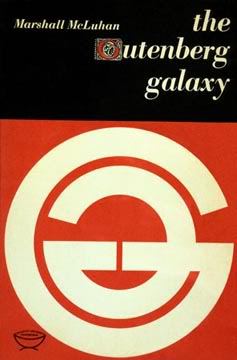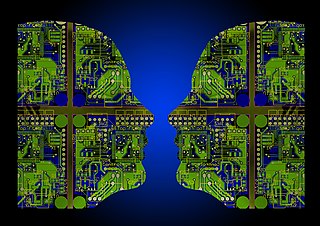Related Research Articles

Herbert Marshall McLuhan was a Canadian philosopher whose work is among the cornerstones of the study of media theory. He studied at the University of Manitoba and the University of Cambridge. He began his teaching career as a professor of English at several universities in the United States and Canada before moving to the University of Toronto in 1946, where he remained for the rest of his life.

Determinism is the philosophical view that events are completely determined by previously existing causes. Deterministic theories throughout the history of philosophy have developed from diverse and sometimes overlapping motives and considerations. Like eternalism, determinism focuses on particular events rather than the future as a concept. The opposite of determinism is indeterminism, or the view that events are not deterministically caused but rather occur due to chance. Determinism is often contrasted with free will, although some philosophers claim that the two are compatible.
Media ecology theory is the study of media, technology, and communication and how they affect human environments. The theoretical concepts were proposed by Marshall McLuhan in 1964, while the term media ecology was first formally introduced by Neil Postman in 1968.

Understanding Media: The Extensions of Man is a 1964 book by Marshall McLuhan, in which the author proposes that the media, not the content that they carry, should be the focus of study. He suggests that the medium affects the society in which it plays a role mainly by the characteristics of the medium rather than the content. The book is considered a pioneering study in media theory.

The Gutenberg Galaxy: The Making of Typographic Man is a 1962 book by Marshall McLuhan, in which he analyzes the effects of mass media, especially the printing press, on European culture and human consciousness. It popularized the term global village, which refers to the idea that mass communication allows a village-like mindset to apply to the entire world; and Gutenberg Galaxy, which we may regard today to refer to the accumulated body of recorded works of human art and knowledge, especially books.

The Medium Is the Massage: An Inventory of Effects is a book co-created by media analyst Marshall McLuhan and graphic designer Quentin Fiore, with coordination by Jerome Agel. It was published by Bantam Books in 1967 and became a bestseller with a cult following. The U.K. edition was published by Allen Lane Penguin Books using cover art by Newsweek photographer Tony Rollo.

Social construction of technology (SCOT) is a theory within the field of science and technology studies. Advocates of SCOT—that is, social constructivists—argue that technology does not determine human action, but that rather, human action shapes technology. They also argue that the ways a technology is used cannot be understood without understanding how that technology is embedded in its social context. SCOT is a response to technological determinism and is sometimes known as technological constructivism.
Theories of technological change and innovation attempt to explain the factors that shape technological innovation as well as the impact of technology on society and culture. Some of the most contemporary theories of technological change reject two of the previous views: the linear model of technological innovation and other, the technological determinism. To challenge the linear model, some of today's theories of technological change and innovation point to the history of technology, where they find evidence that technological innovation often gives rise to new scientific fields, and emphasizes the important role that social networks and cultural values play in creating and shaping technological artifacts. To challenge the so-called "technological determinism", today's theories of technological change emphasize the scope of the need of technical choice, which they find to be greater than most laypeople can realize; as scientists in philosophy of science, and further science and technology often like to say about this "It could have been different." For this reason, theorists who take these positions often argue that a greater public involvement in technological decision-making is desired.
Media transparency, also referred to as transparent media or media opacity, is a concept that explores how and why information subsidies are being produced, distributed and handled by media professionals, including journalists, editors, public relations practitioners, government officials, public affairs specialists, and spokespeople. In short, media transparency reflects the relationship between civilization and journalists, news sources and government. According to a textual analysis of “Information Subsidies and Agenda Building: A Study of Local Radio News”, an information subsidy is defined as “any item provided to the media in order to gain time or space”. In order to understand media transparency, one must gain an understanding of the different aspects in which media transparency is researched, understood, and explored. The following page will attempt to examine media transparency as it has grown and how it affects the modern world.
Media psychology is the branch and specialty field in psychology that focuses on the interaction of human behavior with media and technology. Media psychology is not limited to mass media or media content; it includes all forms of mediated communication and media technology-related behaviors, such as the use, design, impact, and sharing behaviors. This branch is a relatively new field of study because of advancement in technology. It uses various methods of critical analysis and investigation to develop a working model of a user's perception of media experience. These methods are used for society as a whole and on an individual basis. Media psychologists are able to perform activities that include consulting, design, and production in various media like television, video games, films, and news broadcasting. Media psychologists are not considered to be those who are featured in media, rather than those who research, work or contribute to the field.

"The medium is the message" is a phrase coined by the Canadian communication theorist Marshall McLuhan and the name of the first chapter in his Understanding Media: The Extensions of Man, published in 1964. McLuhan proposes that a communication medium itself, not the messages it carries, should be the primary focus of study. He showed that artifacts such as media affect any society by their characteristics, or content.
Medium theory is a mode of analysis that examines the ways in which particular communication media and modalities impact the specific content (messages) they are meant to convey. It Medium theory refers to a set of approaches that can be used to convey the difference in meanings of messages depending on the channel through which they are transmitted. Medium theorists argue that media are not simply channels for transmitting information between environments, but are themselves distinct social-psychological settings or environments that encourage certain types of interaction and discourage others.
Democratic rationalization is term used by Andrew Feenberg in his article "Subversive Rationalization: Technology, Power and Democracy with technology." Feenberg argues against the idea of technological determinism citing flaws in its two fundamental theses. The first is the thesis of unilinear progress. This is the belief that technological progress follows a direct and predictable path from lower to higher levels of complexity and that each stage along this path is necessary for progress to occur.
Global village describes the phenomenon of the entire world becoming more interconnected as the result of the propagation of media technologies throughout the world. The term was coined by Canadian media theorist Marshall McLuhan in his books The Gutenberg Galaxy: The Making of Typographic Man (1962) and Understanding Media (1964). Literary scholar Sue-Im Lee describes how the term global village has come to designate “the dominant term for expressing a global coexistence altered by transnational commerce, migration, and culture”. Economic journalist Thomas Friedman's definition of the global village as a world “tied together into a single globalized marketplace and village” is another contemporary understanding of the term.
Mediation in Marxist theory refers to the reconciliation of two opposing forces within a given society by a mediating object. Put another way "Existence differs from Being by its mediation"...."The Thing-in-itself and its mediated Being are both contained in Existence, and each is an Existence; the Thing-in-it-self exists and is the essential Existence of the Thing, while mediated Being is its unessential Existence ..."
Social determinism is the theory that social interactions alone determine individual behavior.
Technological determinism is a reductionist theory that assumes that a society's technology progresses by following its own internal logic of efficiency, while determining the development of the social structure and cultural values. The term is believed to have originated from Thorstein Veblen (1857–1929), an American sociologist and economist. The most radical technological determinist in the United States in the 20th century was most likely Clarence Ayres who was a follower of Thorstein Veblen and John Dewey. William Ogburn was also known for his radical technological determinism and his theory on cultural lag.
Sociotechnology is the study of processes on the intersection of society and technology. Vojinović and Abbott define it as "the study of processes in which the social and the technical are indivisibly combined". Sociotechnology is an important part of socio-technical design, which is defined as "designing things that participate in complex systems that have both social and technical aspects".
New media studies is an academic discipline that explores the intersections of computing, science, the humanities, and the visual and performing arts. Janet Murray, a prominent researcher in the discipline, describes this intersection as "a single new medium of representation, the digital medium, formed by the braided interplay of technical invention and cultural expression at the end of the 20th century". The main factor in defining new media is the role the Internet plays; new media is effortlessly spread instantly. The category of new media is occupied by devices connected to the Internet, an example being a smartphone or tablet. Television and cinemas are commonly thought of as new media but are ruled out since the invention was before the time of the internet.
In the social sciences, materiality is the notion that the physical properties of a cultural artifact have consequences for how the object is used. Some scholars expand this definition to encompass a broader range of actions, such as the process of making art, and the power of organizations and institutions to orient activity around themselves. The concept of materiality is used across many disciplines within the social sciences to focus attention on the impact of material or physical factors. Scholars working in science and technology studies, anthropology, organization studies, or communication studies may incorporate materiality as a dimension of their investigations. Central figures in the social scientific study of materiality are Harold Innis and Marshall McLuhan.
References
- ↑ Winner, Langdon. "Technologies as Forms of Life". Readings in the Philosophy of Technology. David M. Kaplan. Oxford: Rowman & Littlefield, 2004, ISBN 978-0742564015. 103-113
- ↑ McLuhan, Marshall. Understanding Media: The Extensions of Man. New York: McGraw Hill, 1964.
- ↑ "Media Theory Reading List". home.cc.gatech.edu.
- ↑ "Media Theory Reading List -- Harper Montgomery". csmt.uchicago.edu.
- ↑ "Media Digital Humanities". Archived from the original on 2013-06-03.